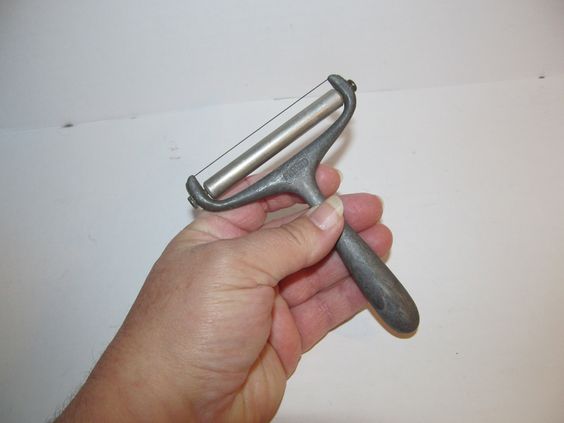Have you ever come across something that caught your eye and made you wonder about its origin and purpose? Today we want to share something remarkable with you. Prepare to be amazed as we solve the mystery surrounding this special gadget.
A humble but essential tool in both home and professional cooking, the history of the cheese slicer is as varied and rich as the cheeses it slices. Reflecting wider changes in culinary techniques and dairy consumption, this straightforward tool was created through a combination of necessity and creativity for easy and precise slicing of cheese.
The history of the cheese slicer begins in Norway in the early 20th century, a country known for its dairy products and customs related to cheese making. Thor Bjorklund, a Norwegian inventor and carpenter, is credited with the invention. In 1925, he became frustrated with the difficulty of consistently cutting slices of cheese with a knife. Bjorklund created the first cheese slicer using his carpentry skills and inspiration from a carpenter’s plane.
With the help of a hardwood handle and a metal blade with an adjustable slot guide, its design allowed the cheese to be cut into evenly thin slices without the use of a knife. This creation revolutionized the way cheese was served and consumed and served as a monument to Bjorklund’s ingenuity and solution to a common kitchen problem. The Bjorklund cheese slicer became famous not only in Norway but also quickly throughout Europe and America.
The device was an essential kitchen tool due to its simplicity and efficiency. Its ability to provide consistent slices of cheese with little effort and waste makes it particularly appealing to both households and restaurants. The cheese slicer was a common kitchen appliance in many Western kitchens in the mid-20th century, a sign of the increasing popularity of cheese as a main dish.

The design of the cheese slicer has changed over time as new materials and mechanisms have been added to accommodate a wider range of cheese varieties and user preferences. The classic manual version with a tight wire cutter is still used today, although more complex models are available with moving rollers and blades for cutting cheese of different hardness. The fact that the basic idea of Bjorklund’s original design has not changed despite these changes is a testament to its continued usefulness and effectiveness.
Wider changes in cuisine and culture are also reflected in the history of the cheese slicer. The invention and widespread use of the gadget occurs at a time when patterns of food production and consumption are undergoing substantial changes.
Due to changes in lifestyle and technology, the early 20th century saw a shift towards more standardized and convenient methods of preparing meals. The cheese slicer in this context symbolizes a shift towards greater uniformity and efficiency in food preparation in accordance with the broader trends of the day.

In addition, the widespread use of cheese slicers highlights the spread of cheese as a food element throughout the world. Once a provincial specialty, cheese is now consumed in a variety of ways around the world. The cheese slicer has subtly but significantly contributed to this globalization of food by making the consumption of cheese easier and more enjoyable.
Have you ever come across an object that piqued your curiosity and made you question its origin and purpose? Today we embark on a fascinating journey to unravel the mystery surrounding a humble but essential culinary tool: the cheese slicer.
The history of the cheese slicer is as varied and delicious as the cheeses it effortlessly slices. Originating in Norway in the early 20th century, the cheese slicer was the brainchild of Thor Bjorklund, a Norwegian inventor and cabinetmaker. Frustrated with the difficulty of cutting cheese consistently with a knife, Bjorklund ingeniously created the first cheese slicer using his carpentry skills and inspiration from a carpenter’s plane. This invention revolutionized the serving and eating of cheese, embodied Bjorklund’s creativity, and solved a common kitchen dilemma.
The Bjorklund cheese slicer quickly gained popularity throughout Europe and America, becoming an essential kitchen tool known for its simplicity and efficiency. Over time, the cheese slicer’s design has evolved to accommodate different types of cheese and user preferences, but its basic concept has remained unchanged, a testament to its enduring utility.
In addition to its practicality, the cheese slicer reflects broader shifts in culinary practices and cultural trends. As patterns of food production and consumption underwent significant changes in the early 20th century, the cheese slicer symbolized a shift toward standardized and convenient methods of food preparation. In addition, the widespread adoption of cheese slicers has contributed to the globalization of cheese consumption, making it more accessible and enjoyable worldwide.

In short, a cheese slicer is more than just a kitchen tool; it is a symbol of innovation, culinary history, and cultural change. From its humble beginnings in Thor Bjorklund’s workshop to its ubiquitous presence in kitchens around the world, the cheese slicer’s journey underscores the profound impact simple inventions have had on our way of life and cooking practices. They serve as a reminder that even the most ordinary objects can tell extraordinary stories, enriching our understanding of the past and shaping our culinary experiences for generations to come.

